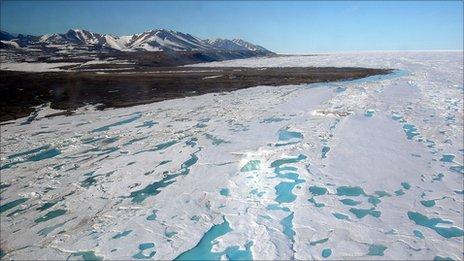Arctic 'tipping point' may not be reached
- Published

The team said they had found an indirect method to give a picture of the ice cover dating back 11,000 years
Scientists say current concerns over a tipping point in the disappearance of Arctic sea ice may be misplaced.
Danish researchers analysed ancient pieces of driftwood in north Greenland which they say is an accurate way to measure the extent of ancient ice loss.
Writing in the journal Science, external, the team found evidence that ice levels were about 50% lower 5,000 years ago.
They say changes to wind systems can slow down the rate of melting.
They argue, therefore, that a tipping point under current scenarios is unlikely.
While modern observations by ship and by satellite give us a very accurate picture of the recent state of the ice, historic information is limited. The ice comes and goes without leaving a permanent record.
But a Danish team believes it has found an indirect method that gives a clear picture of the ice loss dating back 11,000 years.
Dr Svend Funder from the Natural History Museum of Denmark led several expeditions to inhospitable regions of Northern Greenland. On these frozen shores the Danish team noticed several pieces of ancient driftwood. They concluded that it could be an important method of unlocking the secrets of the ancient ice.
"Driftwood cannot float across the water, it has to be ferried across the ocean on ice, and this voyage takes several years, which means that driftwood is actually a signal of multi-year sea ice in the ocean and it is this ice that is at risk at the moment," said Dr Funder.
Carbon dating was used to determine the age of the wood. And figuring out its origins also yielded important information.
"It's so lovely that drift wood from Siberia is mainly larch and from North America is mainly spruce. So if we see there was more larch or spruce we can see that the wind system had changed and in some periods there was little spruce and in other periods there was lots," he said.
Wind delay?
As well as the driftwood, the scientists mapped beach ridges for 500km (310 miles) along the coast. This proved that at one time the waves had reached the shore unhindered by the ice.
Dr Funder and his team say their data shows a clear connection between temperature and the amount of sea ice. The researchers concluded that for about 3,000 years, during a period called the Holocene Climate Optimum, there was more open water and far less ice than today - probably less than 50% of the minimum Arctic sea ice recorded in 2007.
But the researcher says that even with a loss of this size, the sea ice will not reach a point of no return.
"I think we can say that with the loss of 50% of the current ice, the tipping point wasn't reached."
The idea of an Arctic tipping point has been highlighted by many scientists in recent years. They have argued that when enough ice is lost it could cause a runaway effect with disastrous consequences.
"I don't say that our current worries are not justified, but I think that there are factors which will work to delay the action in relation to some of the models that have been in the media.
"I think the effect of temperature and global warming may cause a change in the general wind systems which maybe will delay the effects of the rapidly rising temperatures a little bit."
The researchers are now set to examine DNA from the fossils of polar bears to try and find out how the animals fared when the temperatures were higher and there was much less ice.
- Published8 April 2011